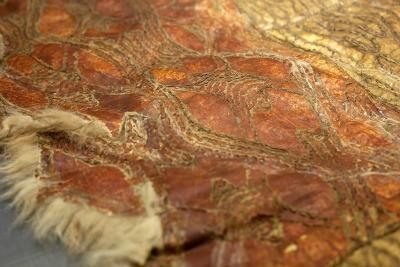Ancient Traditions, New Stories: Reviving the Aboriginal Possum Skin Cloak
Photographer Sarah Rhodes documents how aboriginal communities in Australia are reclaiming their heritage
/https://tf-cmsv2-smithsonianmag-media.s3.amazonaws.com/filer/e4/07/e407cdfb-a3c1-4e11-8656-28744d249a30/possum31.jpg)
For generations, every aboriginal infant born in southeastern Australia was swaddled in a possum skin pelt covered in symbols explaining their family ties, their lands, and their place in the larger community. The cloak, worn every day and slept in every night, grew with the child; over the years, more possum pelts, loaded with descriptions of new stories and new relationships, were attached to that first panel. And when the person died, the cloak became a burial shroud, depicting a full life story.
This vital tradition disappeared in the late 19th century, as British colonization of Australia led to the demise of aboriginal culture. Only five original cloaks have been preserved—including one stored in the Natural History Museum.
But in the past decade, modern aboriginal Australians have been pushing a cultural revival. The possum skin cloak, with its thorough mapping of different aboriginal groups’ languages, clans, terrain, spirituality and history, has come to symbolize the movement.
When the Sydney-based photographer, Sarah Rhodes, first stumbled on an online image of a modern possum skin cloak while working at Sydney’s Powerhouse Museum, the cloak seized her imagination.
“I went home that night and had a dream that I was photographing this opera singer backstage at the Sydney Opera House,” Rhodes recalls. “She was wearing this cloak in this very theatrical way. And when I woke up the next morning, I thought it was a sign that I needed to do something.”
A year later, she quit her job at the museum and became a full-time photographer, chasing the story of the cloak all over the continent. Rhodes met Vicki Couzens, a leader in the aboriginal pride movement. In 2006, she organized an aboriginal heritage event that took place at the Melbourne Commonwealth Games in which tribal elders wore newly crafted possum skin cloaks. Since the games, cloak-making workshops and ceremonies have popped up in many communities. In an essay about her first encounter with an original cloak, Couzens describes its visceral power:
“It seemed, in that moment, that the Old People were standing there beside and around us. I felt as if the illusionary veils of time, space and place had thinned, dissipated and I could reach through and feel them, touch and see the Old People.”

With Couzens’ help, Rhodes embarked on a photographic series, “Home/On Country,” portraits of elders wrapped in possum skin cloaks much like the “Old People” of the past. At first, she photographed the elders in their houses. But she soon realized the incongruity of the cloak in a modern home. She started photographing the elders out in the wilderness, where the cloak seemed fully in its element. She notes the difference in the face of one elder, Esther Kirby, in each setting (see above). “Look at her face, she’s so calm . But in this room she looks so tense,” she says. “These pictures made me realize how difficult it is to negotiate two cultures.”
Rhodes traveled to Washington last week after visiting a possum skin cloak workshop in Newcastle, New South Wales, the region where the Smithsonian cloak was first discovered. The Newcastle workshop is creating a replica, but has no detailed images of the original designs. So Rhodes photographed the cloak at the Natural History Museum in all its intricacy. Soon, she’ll return to Newcastle to document the labor-intensive process of recreating the cloak. Though the craft of the cloak interests her, at heart Rhodes wants to show what the project means for the community.
“It’s not really about the cloak. It’s a vehicle for the whole of knowledge reclamation,” Rhodes explains.
Indeed, the artifact is more than just a garment; it’s a pictographic dictionary, a geographical map, an autobiography, and, crucially, an education tool. The workshops, according to Rhodes, are packed with children learning about their history. After centuries of stigma, the younger generations will grow up immersed in their culture and see it as a source of pride.
As an example, Rhodes offers Vicki Couzens’ own family story. Couzens’ father was raised in a European mission, which discouraged his native culture. Couzens herself faced racism growing up and was made to feel ashamed of her heritage. When she started the possum skin cloak revival project, she taught her daughter everything.
Now, her daughter has made a possum skin cloak for her newborn son. Rhodes marvels, “And now her son will grow up like his great-great-grandfather did.”
/https://tf-cmsv2-smithsonianmag-media.s3.amazonaws.com/accounts/headshot/ATM-aviva-shen-240.jpg)
/https://tf-cmsv2-smithsonianmag-media.s3.amazonaws.com/accounts/headshot/ATM-aviva-shen-240.jpg)